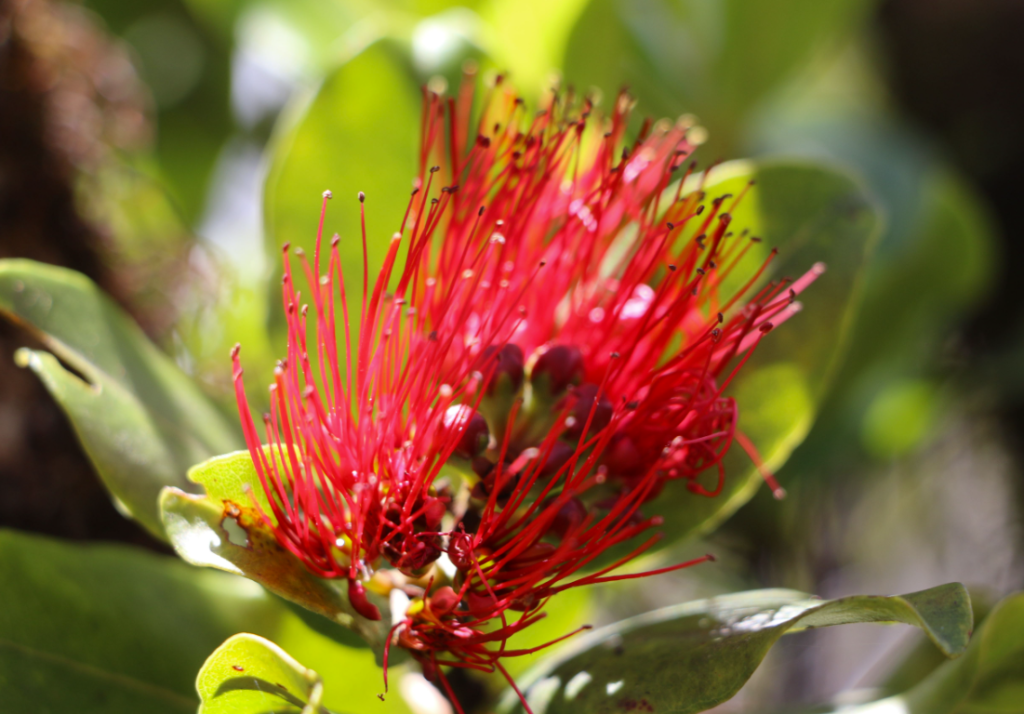04/10/23 – RAPID ʻŌHIʻA DEATH DETECTED FOR FIRST TIME IN WAIʻANAE MOUNTAINS
Posted on Apr 10, 2023 in Forestry & Wildlife, Main, News Releases, slider| JOSH GREEN, M.D. GOVERNOR |
DAWN CHANG
CHAIRPERSON |
For Immediate Release: April 10, 2023
RAPID ʻŌHIʻA DEATH DETECTED FOR FIRST TIME IN WAIʻANAE MOUNTAINS
More aggressive strain still absent from Oʻahu
To view video please click on photo or view at this link: https://vimeo.com/781530520
(HONOLULU) – Rapid ʻŌhiʻa Death (ROD), a disease caused by fungal pathogens that impacts native ʻōhiʻa trees, was recently detected for the first time in the Waiʻanae mountain range on Oʻahu.
Previously, the Oʻahu-based detections of the disease had been limited to multiple locations within the Koʻolau range. During invasive species surveys conducted by the Oʻahu Invasive Species Committee (OISC), a roughly 40-foot ʻōhiʻa tree was found exhibiting symptoms of ROD. OISC collected a sample of the tree and sent it to the U.S. Department of Agriculture’s Agriculture Research Service lab in Hilo for analysis. It was confirmed that Ceratocystis huliohia, the less aggressive of two fungal strains that cause ROD, was present.
A team from the DLNR Division of Forestry and Wildlife (DOFAW) and OISC returned to the fallen tree to keep infected material from spreading. Although Ceratocystis huliohia is less aggressive, it can still be fatal to ʻōhiʻa trees. Another discovery in Kāneʻohe, brings the total positive ROD detections on Oʻahu to 12, six on residential properties and six in forested, wildland areas. The more aggressive ROD species, Ceratocystis lukuohia, is currently limited to Hawaiʻi Island and Kauaʻi.
In 2016, a partnership of state, federal, university, and non-government organizations began conducting systematic helicopter and ground surveys for ROD. Since then, more than 400 dead or unhealthy ʻōhiʻa trees on Oʻahu have been sampled for the disease, with the first positive detection in 2019.
Dead or unhealthy ʻōhiʻa trees with reddish or brown leaves attached can be reported by submitting a photo at: www.643PEST.org or emailing a photo to the Oʻahu Invasive Species Committee: [email protected].
Residents and visitors can help protect remaining ʻōhiʻa forests with the following actions:
- Avoid injuring ʻōhiʻa. Open wounds on ʻōhiʻa are an entry point for disease spores. The disease can also spread from tree to tree on machetes or other tools.
- Don’t transport ʻōhiʻa inter-island.
- Don’t move ʻōhiʻa wood or vegetation.
- Clean your hiking boots/gear/tools. Scrub off all dirt and spray boot soles and tools with 70% rubbing alcohol, wash your clothes in hot water, and use a dryer to ensure the disease is not spread on boots and clothing.
- Wash your vehicle if driving near ʻōhiʻa forests. The disease can remain alive and infectious in soil, so wash all dirt off on vehicles.
# # #
RESOURCES
(All images/video courtesy: DLNR)
HD Video – Best of Ohia Around Hawaii (Dec. 15, 2022): https://vimeo.com/781530520
Photographs – Ohia-Alaka’i Plateau (April, 18, 2019): https://www.dropbox.com/sh/981k5cb6u80m148/AABamiWdMzzFK6YUtX4_lDS3a?dl=0
Media Contact:
Madison Rice
Communications Specialist
Hawai‘i Dept. of Land and Natural Resources

